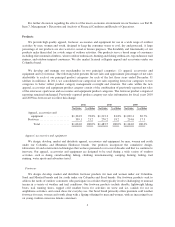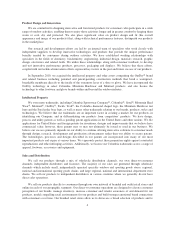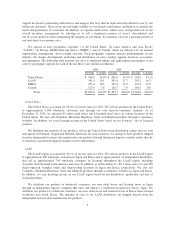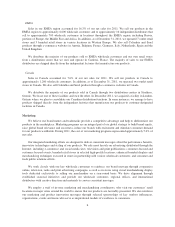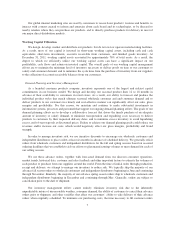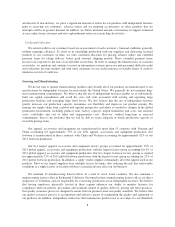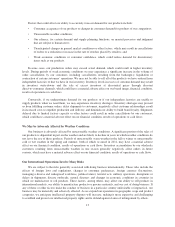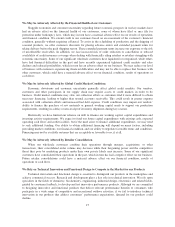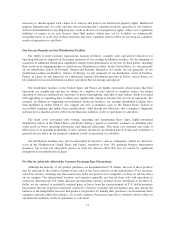Columbia Sportswear 2011 Annual Report Download - page 18
Download and view the complete annual report
Please find page 18 of the 2011 Columbia Sportswear annual report below. You can navigate through the pages in the report by either clicking on the pages listed below, or by using the keyword search tool below to find specific information within the annual report.Factors that could affect our ability to accurately forecast demand for our products include:
• Consumer acceptance of our products or changes in consumer demand for products of our competitors;
• Unseasonable weather conditions;
• Our reliance, for certain demand and supply planning functions, on manual processes and judgment
that are subject to human error;
• Unanticipated changes in general market conditions or other factors, which may result in cancellations
of orders or a reduction or increase in the rate of reorders placed by retailers; and
• Weak economic conditions or consumer confidence, which could reduce demand for discretionary
items such as our products.
In some cases, our production orders may exceed actual demand, which could result in higher inventory
levels. During periods of weak economic conditions we may experience a significant increase in the volume of
order cancellations by our customers, including cancellations resulting from the bankruptcy, liquidation or
contraction of certain customers’ operations. We may not be able to sell all of the products we have ordered from
independent factories or that we have in our inventory. Inventory levels in excess of customer demand may result
in inventory write-downs and the sale of excess inventory at discounted prices through discount
direct-to-consumer channels, which could have a material adverse effect on our brand image, financial condition,
results of operations or cash flows.
Conversely, if we underestimate demand for our products or if our independent factories are unable to
supply products when we need them, we may experience inventory shortages. Inventory shortages may prevent
us from fulfilling customer orders, delay shipments to customers, negatively affect customer relationships, result
in increased costs to expedite production and delivery, and diminish our ability to build brand loyalty. Shipments
delayed due to limited factory capacity or other factors could result in order cancellations by our customers,
which could have a material adverse effect on our financial condition, results of operations or cash flows.
We May be Adversely Affected by Weather Conditions
Our business is adversely affected by unseasonable weather conditions. A significant portion of the sales of
our products is dependent in part on the weather and are likely to decline in years in which weather conditions do
not favor the use of these products. Periods of unseasonably warm weather in the fall or winter or unseasonably
cold or wet weather in the spring and summer, both of which occurred in 2011, may have a material adverse
effect on our financial condition, results of operations or cash flows. Inventory accumulation by our wholesale
customers resulting from unseasonable weather in one season generally negatively affect orders in future
seasons, which may have a material adverse effect on our financial condition, results of operations or cash flows.
Our International Operations Involve Many Risks
We are subject to the risks generally associated with doing business internationally. These risks include the
effects of foreign laws and regulations, changes in consumer preferences, foreign currency fluctuations,
managing a diverse and widespread workforce, political unrest, terrorist acts, military operations, disruptions or
delays in shipments, disease outbreaks, natural disasters and changes in economic conditions in countries in
which we manufacture or sell products. These factors, among others, may affect our ability to sell products in
international markets, our ability to manufacture products or procure materials, and our cost of doing business. If
any of these or other factors make the conduct of business in a particular country undesirable or impractical, our
business may be materially and adversely affected. As we expand our operations in geographic scope and product
categories, we anticipate intellectual property disputes will increase, making it more expensive and challenging
to establish and protect our intellectual property rights and to defend against claims of infringement by others.
13


